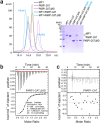HPF1 remodels the active site of PARP1 to enable the serine ADP-ribosylation of histones
- PMID: 33589610
- PMCID: PMC7884425
- DOI: 10.1038/s41467-021-21302-4
HPF1 remodels the active site of PARP1 to enable the serine ADP-ribosylation of histones
Abstract
Upon binding to DNA breaks, poly(ADP-ribose) polymerase 1 (PARP1) ADP-ribosylates itself and other factors to initiate DNA repair. Serine is the major residue for ADP-ribosylation upon DNA damage, which strictly depends on HPF1. Here, we report the crystal structures of human HPF1/PARP1-CAT ΔHD complex at 1.98 Å resolution, and mouse and human HPF1 at 1.71 Å and 1.57 Å resolution, respectively. Our structures and mutagenesis data confirm that the structural insights obtained in a recent HPF1/PARP2 study by Suskiewicz et al. apply to PARP1. Moreover, we quantitatively characterize the key residues necessary for HPF1/PARP1 binding. Our data show that through salt-bridging to Glu284/Asp286, Arg239 positions Glu284 to catalyze serine ADP-ribosylation, maintains the local conformation of HPF1 to limit PARP1 automodification, and facilitates HPF1/PARP1 binding by neutralizing the negative charge of Glu284. These findings, along with the high-resolution structural data, may facilitate drug discovery targeting PARP1.
Conflict of interest statement
The authors declare no competing interests.
Figures




Similar articles
-
HPF1 completes the PARP active site for DNA damage-induced ADP-ribosylation.Nature. 2020 Mar;579(7800):598-602. doi: 10.1038/s41586-020-2013-6. Epub 2020 Feb 6. Nature. 2020. PMID: 32028527 Free PMC article.
-
HPF1 dynamically controls the PARP1/2 balance between initiating and elongating ADP-ribose modifications.Nat Commun. 2021 Nov 18;12(1):6675. doi: 10.1038/s41467-021-27043-8. Nat Commun. 2021. PMID: 34795260 Free PMC article.
-
Dual function of HPF1 in the modulation of PARP1 and PARP2 activities.Commun Biol. 2021 Nov 3;4(1):1259. doi: 10.1038/s42003-021-02780-0. Commun Biol. 2021. PMID: 34732825 Free PMC article.
-
Serine ADP-ribosylation in DNA-damage response regulation.Curr Opin Genet Dev. 2021 Dec;71:106-113. doi: 10.1016/j.gde.2021.07.005. Epub 2021 Jul 31. Curr Opin Genet Dev. 2021. PMID: 34340015 Review.
-
Mechanistic insight into the role of Poly(ADP-ribosyl)ation in DNA topology modulation and response to DNA damage.Mutagenesis. 2020 Feb 13;35(1):107-118. doi: 10.1093/mutage/gez045. Mutagenesis. 2020. PMID: 31782485 Review.
Cited by
-
Rapid Analysis of ADP-Ribosylation Dynamics and Site-Specificity Using TLC-MALDI.ACS Chem Biol. 2021 Nov 19;16(11):2137-2143. doi: 10.1021/acschembio.1c00542. Epub 2021 Oct 14. ACS Chem Biol. 2021. PMID: 34647721 Free PMC article.
-
Slow Dissociation from the PARP1-HPF1 Complex Drives Inhibitor Potency.Biochemistry. 2023 Aug 15;62(16):2382-2390. doi: 10.1021/acs.biochem.3c00243. Epub 2023 Aug 2. Biochemistry. 2023. PMID: 37531469 Free PMC article.
-
General ADP-Ribosylation Mechanism Based on the Structure of ADP-Ribosyltransferase-Substrate Complexes.Toxins (Basel). 2024 Jul 11;16(7):313. doi: 10.3390/toxins16070313. Toxins (Basel). 2024. PMID: 39057953 Free PMC article. Review.
-
HPF1-dependent histone ADP-ribosylation triggers chromatin relaxation to promote the recruitment of repair factors at sites of DNA damage.Nat Struct Mol Biol. 2023 May;30(5):678-691. doi: 10.1038/s41594-023-00977-x. Epub 2023 Apr 27. Nat Struct Mol Biol. 2023. PMID: 37106138
-
The function and regulation of ADP-ribosylation in the DNA damage response.Biochem Soc Trans. 2023 Jun 28;51(3):995-1008. doi: 10.1042/BST20220749. Biochem Soc Trans. 2023. PMID: 37171085 Free PMC article.
References
Publication types
MeSH terms
Substances
LinkOut - more resources
Full Text Sources
Other Literature Sources
Molecular Biology Databases
Miscellaneous

